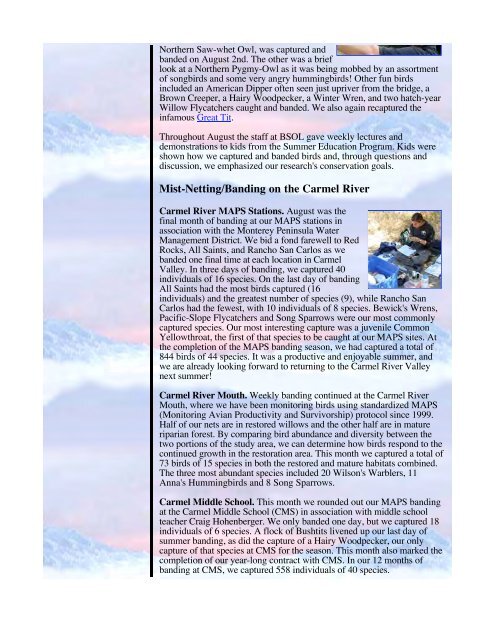2003 Bird Lab updates - Ventana Wildlife Society
2003 Bird Lab updates - Ventana Wildlife Society
2003 Bird Lab updates - Ventana Wildlife Society
You also want an ePaper? Increase the reach of your titles
YUMPU automatically turns print PDFs into web optimized ePapers that Google loves.
Northern Saw-whet Owl, was captured and<br />
banded on August 2nd. The other was a brief<br />
look at a Northern Pygmy-Owl as it was being mobbed by an assortment<br />
of songbirds and some very angry hummingbirds! Other fun birds<br />
included an American Dipper often seen just upriver from the bridge, a<br />
Brown Creeper, a Hairy Woodpecker, a Winter Wren, and two hatch-year<br />
Willow Flycatchers caught and banded. We also again recaptured the<br />
infamous Great Tit.<br />
Throughout August the staff at BSOL gave weekly lectures and<br />
demonstrations to kids from the Summer Education Program. Kids were<br />
shown how we captured and banded birds and, through questions and<br />
discussion, we emphasized our research's conservation goals.<br />
Mist-Netting/Banding on the Carmel River<br />
Carmel River MAPS Stations. August was the<br />
final month of banding at our MAPS stations in<br />
association with the Monterey Peninsula Water<br />
Management District. We bid a fond farewell to Red<br />
Rocks, All Saints, and Rancho San Carlos as we<br />
banded one final time at each location in Carmel<br />
Valley. In three days of banding, we captured 40<br />
individuals of 16 species. On the last day of banding<br />
All Saints had the most birds captured (16<br />
individuals) and the greatest number of species (9), while Rancho San<br />
Carlos had the fewest, with 10 individuals of 8 species. Bewick's Wrens,<br />
Pacific-Slope Flycatchers and Song Sparrows were our most commonly<br />
captured species. Our most interesting capture was a juvenile Common<br />
Yellowthroat, the first of that species to be caught at our MAPS sites. At<br />
the completion of the MAPS banding season, we had captured a total of<br />
844 birds of 44 species. It was a productive and enjoyable summer, and<br />
we are already looking forward to returning to the Carmel River Valley<br />
next summer!<br />
Carmel River Mouth. Weekly banding continued at the Carmel River<br />
Mouth, where we have been monitoring birds using standardized MAPS<br />
(Monitoring Avian Productivity and Survivorship) protocol since 1999.<br />
Half of our nets are in restored willows and the other half are in mature<br />
riparian forest. By comparing bird abundance and diversity between the<br />
two portions of the study area, we can determine how birds respond to the<br />
continued growth in the restoration area. This month we captured a total of<br />
73 birds of 15 species in both the restored and mature habitats combined.<br />
The three most abundant species included 20 Wilson's Warblers, 11<br />
Anna's Hummingbirds and 8 Song Sparrows.<br />
Carmel Middle School. This month we rounded out our MAPS banding<br />
at the Carmel Middle School (CMS) in association with middle school<br />
teacher Craig Hohenberger. We only banded one day, but we captured 18<br />
individuals of 6 species. A flock of Bushtits livened up our last day of<br />
summer banding, as did the capture of a Hairy Woodpecker, our only<br />
capture of that species at CMS for the season. This month also marked the<br />
completion of our year-long contract with CMS. In our 12 months of<br />
banding at CMS, we captured 558 individuals of 40 species.






